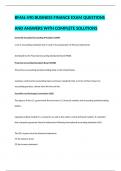Exam (elaborations)
BMAL-590 BUSINESS FINANCE EXAM QUESTIONS AND ANSWERS WITH COMPLETE SOLUTIONS
- Course
- Institution
BMAL-590 BUSINESS FINANCE EXAM QUESTIONS AND ANSWERS WITH COMPLETE SOLUTIONS Generally Accepted Accounting Principles (GAAP) a set of accounting standards that is used in the preparation of financial statements developed by the Financial Accounting Standards Board (FASB) Financial Accounting ...
[Show more]



